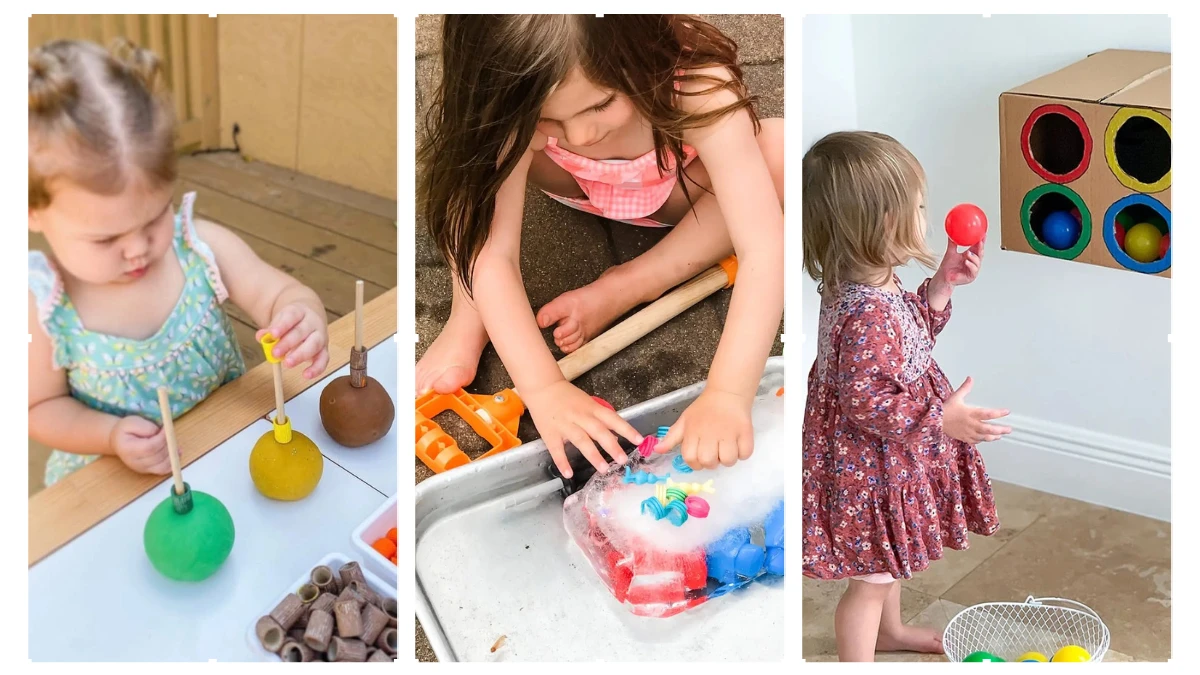Your toddler’s boundless energy needs an outlet, and you’re running out of ideas to keep them engaged and happy.
What if you had a toolkit of simple, entertaining activities that spark joy and learning without breaking the bank or requiring elaborate setup?
These fun activities for toddlers transform ordinary moments into opportunities for growth, creativity, and precious bonding time that tires them out in the best way possible.
31 Best Screen-Free Fun Activities for Toddlers That Actually Work
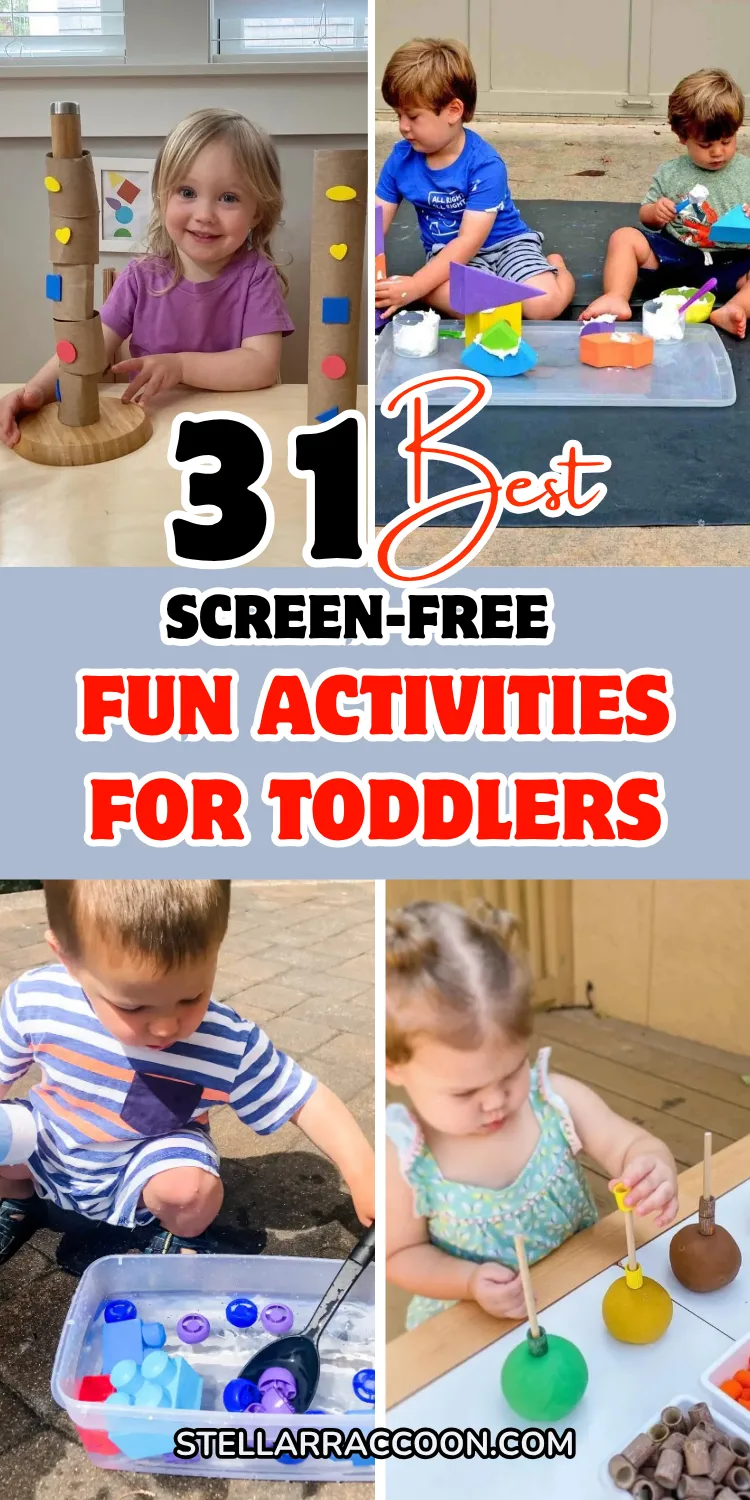
1. DIY Cardboard Tube Shape Tower
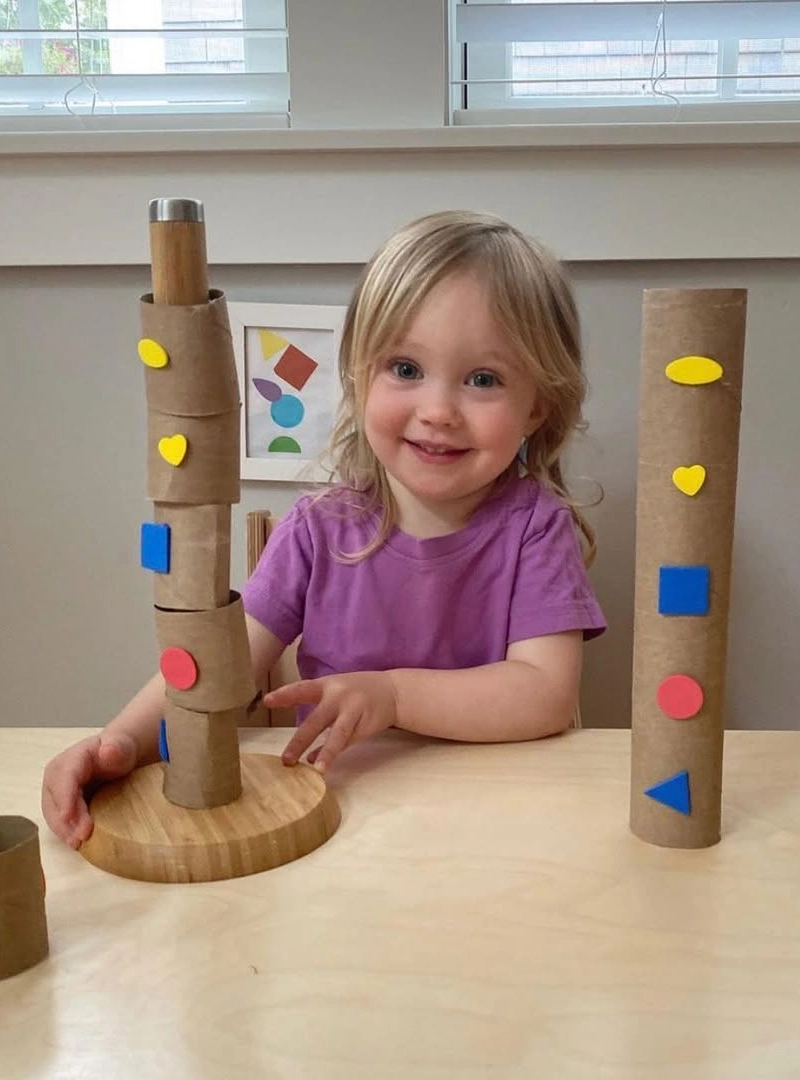
DIY Cardboard Tube Shape Tower is a fun, educational activity where kids stack and sort cardboard tubes (like toilet paper rolls) by size, shape, or color. They can build tall towers, create patterns, or even decorate the tubes with paint and stickers for added creativity.
This hands-on game enhances fine motor skills, spatial awareness, and problem-solving as children balance the tubes to prevent their structure from toppling. Parents can join in, turning it into a playful competition—who can build the tallest or most unique tower?
It’s amazing how something destined for recycling becomes hours of educational entertainment!
2. Floating Laboratory
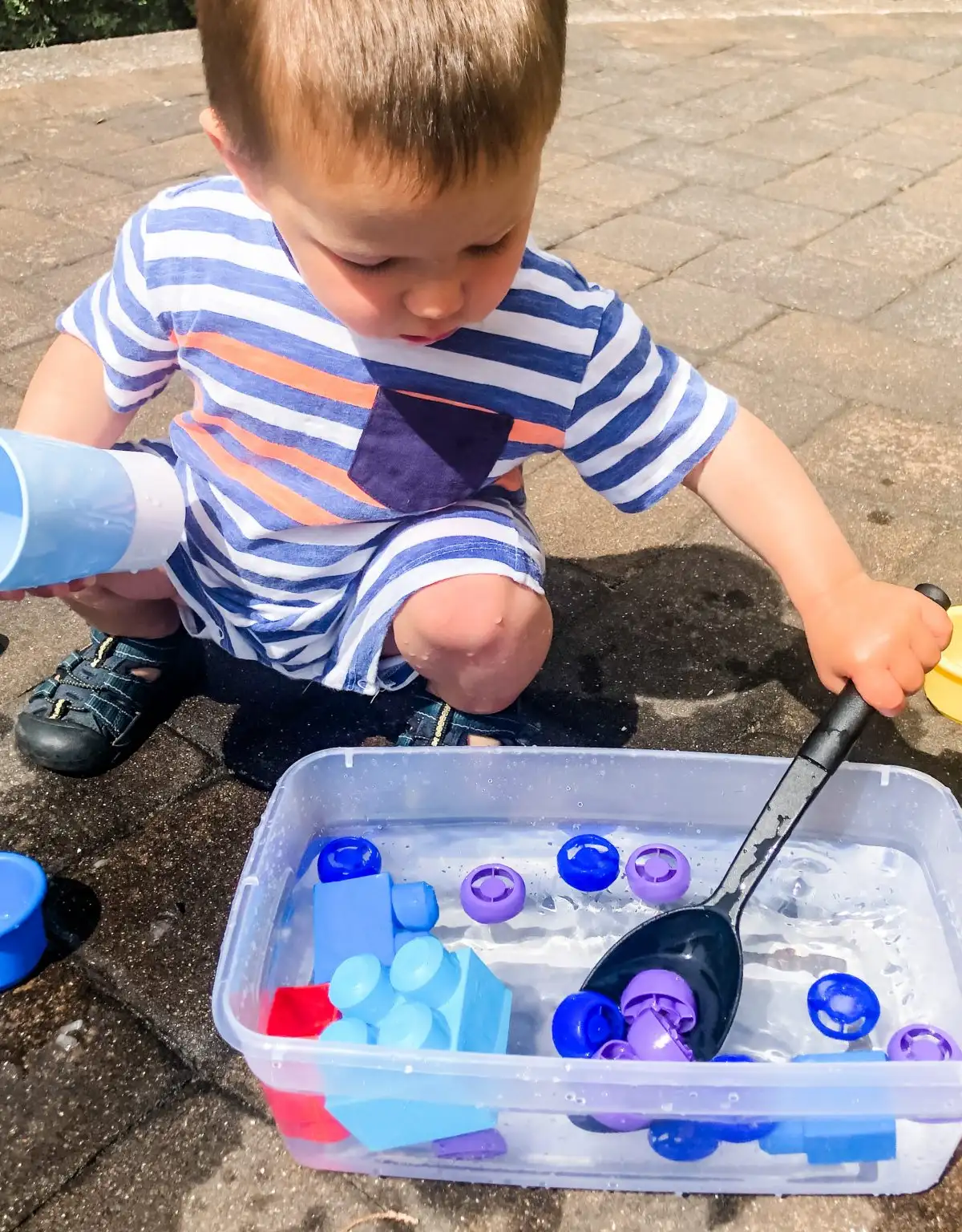
Most dedicated water scientist has set up his own floating laboratory, complete with various containers, measuring tools, and colorful specimens. The intense concentration shows he’s conducting serious experiments about buoyancy, displacement, and volume.
Each blue and purple container becomes a test subject as he explores which ones float, sink, or hold the most water. His ladle serves as both a measuring device and a transfer tool in his aquatic research.
Simple water play transforms into complex scientific thinking when curious minds get the right tools to explore.
3. Colorful Easter Egg Sorting Activity

Your toddler can practice their fine motor skills by transferring bright plastic eggs between containers using tongs or their fingers. Set up a simple tray with different colored eggs and let them sort by color, size, or just enjoy the satisfying plop as eggs land in the metal bowl.
This activity keeps curious minds engaged while building hand-eye coordination. Perfect for rainy afternoons when you need something that’s both entertaining and educational. Plus, cleanup is a breeze since everything stays contained in the tray!
4. Playdough Popsicle Making Station
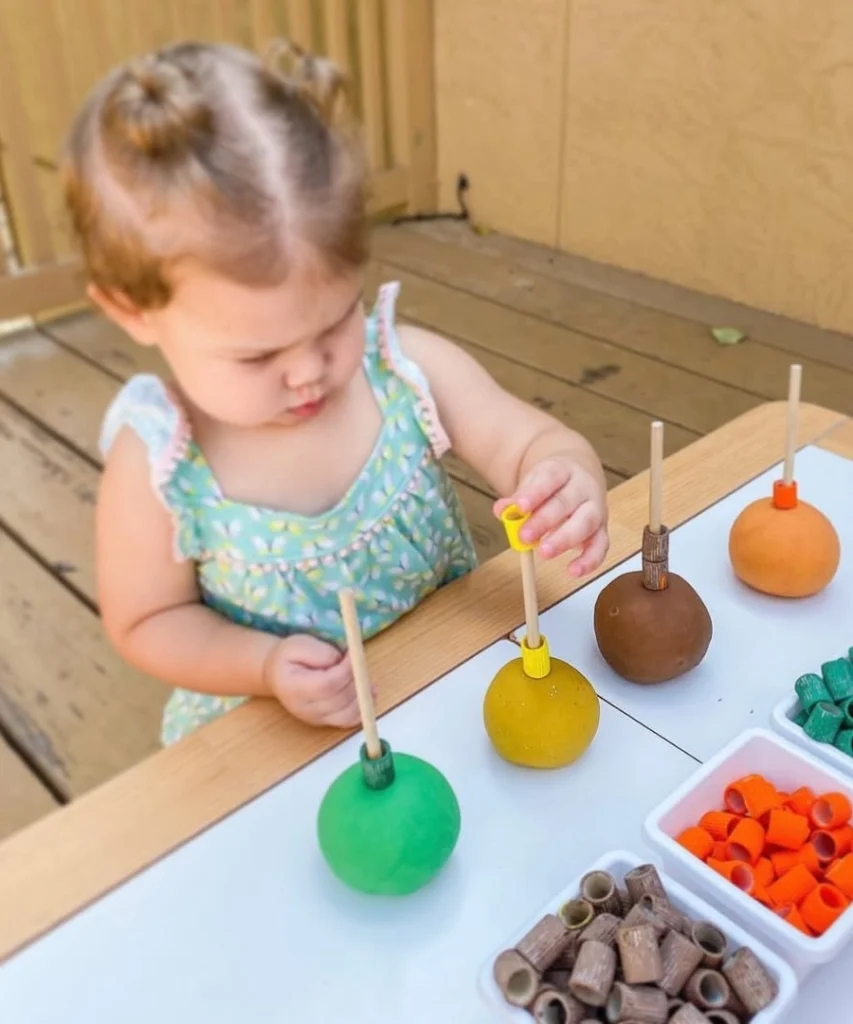
Roll out different colored playdough into balls, then let your little chef create pretend popsicles by pushing wooden sticks right through the center. Add small decorative pieces like beads or pasta shapes to make each creation unique.
Kids love the satisfying squish of dough and the pride of making something that looks real. This hands-on activity strengthens finger muscles while encouraging creativity.
4. Beach-Themed Sensory Pool

Fill an inflatable pool with kinetic sand, add some water, and toss in beach toys for authentic seaside fun. Hidden treasures like shells and small toys create exciting discoveries as little hands dig through the sand.
The combination of wet and dry textures provides rich sensory input that toddlers crave. The contained mess means parents can relax while kids explore different textures, temperatures, and weights in their backyard ocean adventure.
5. Pouring Practice with Colorful Glasses
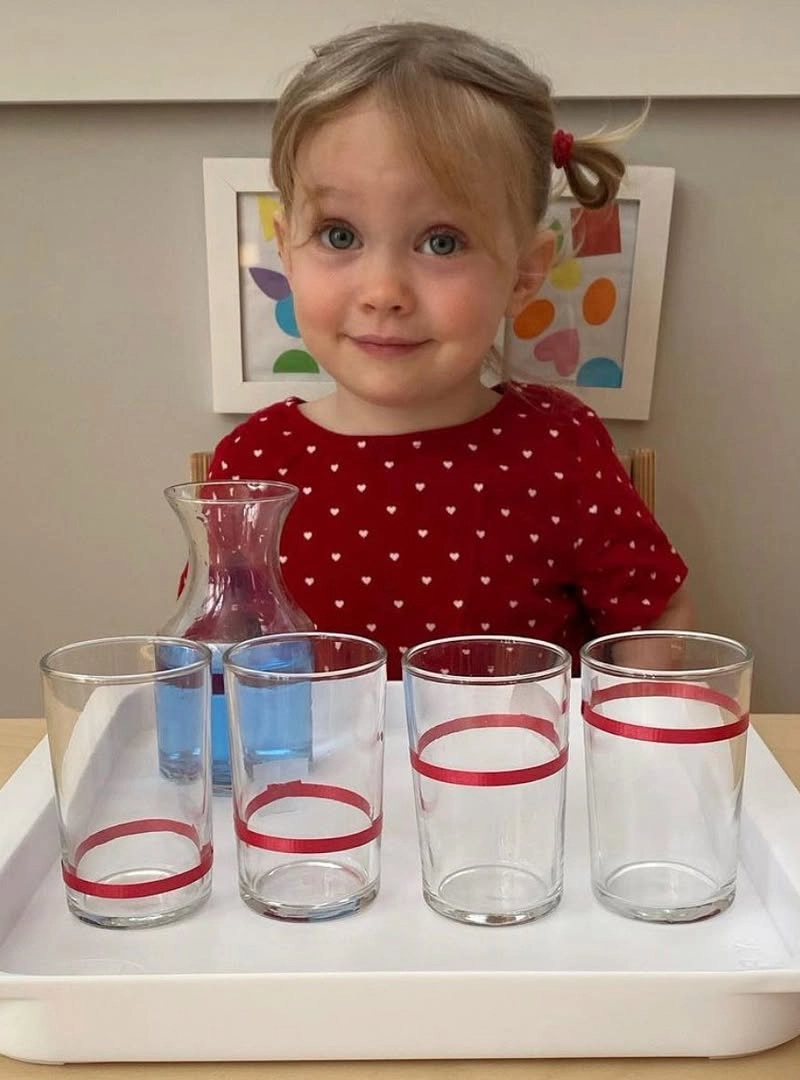
Set up a simple water station with a pitcher and several glasses, some with red stripes to make it extra special. Your toddler will spend ages transferring water back and forth, building those crucial hand-eye coordination skills.
The concentration on her face says it all! This activity keeps busy hands occupied while secretly teaching measurements and motor control. Just lay down a towel and let them explore.
5. DIY Cardboard Truck Ball Drop

Cut holes in the top and sides of a large box, then watch your little engineer drop colorful balls through different openings.
The excitement of seeing where each ball lands never gets old. This clever parent added wheels and turned it into a vehicle, doubling the fun factor.
Your toddler learns cause and effect while developing fine motor skills. Plus, when they’re done playing, the whole thing can be recycled. Win-win for parents and planet!
6. Number Ball Matching Game
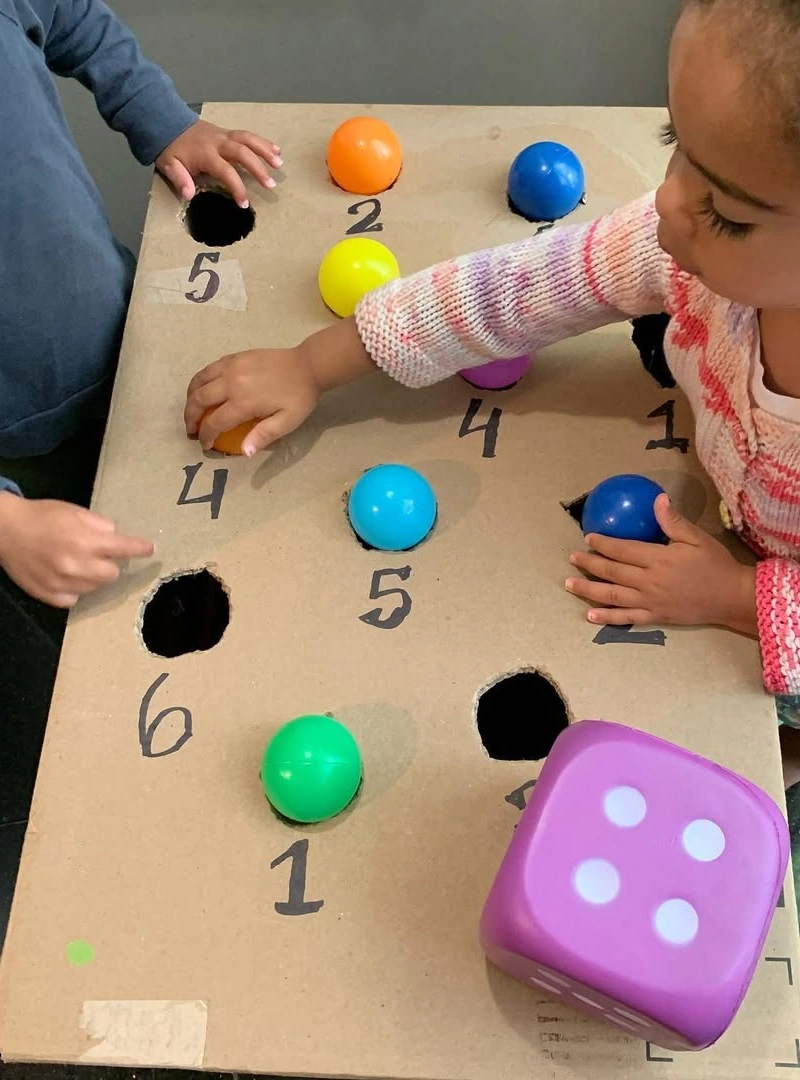
Transform a cardboard sheet into an engaging number learning experience. Cut circular holes and write numbers beside each one, then let your toddler match colored balls to their corresponding spots.
The purple dice adds an extra challenge. Roll it and find that number! Two children working together makes it even more engaging, encouraging social skills alongside mathematical concepts.
It’s incredible how cardboard, a marker, and some craft balls can create such meaningful learning opportunities.
7. Block Building Masterpiece
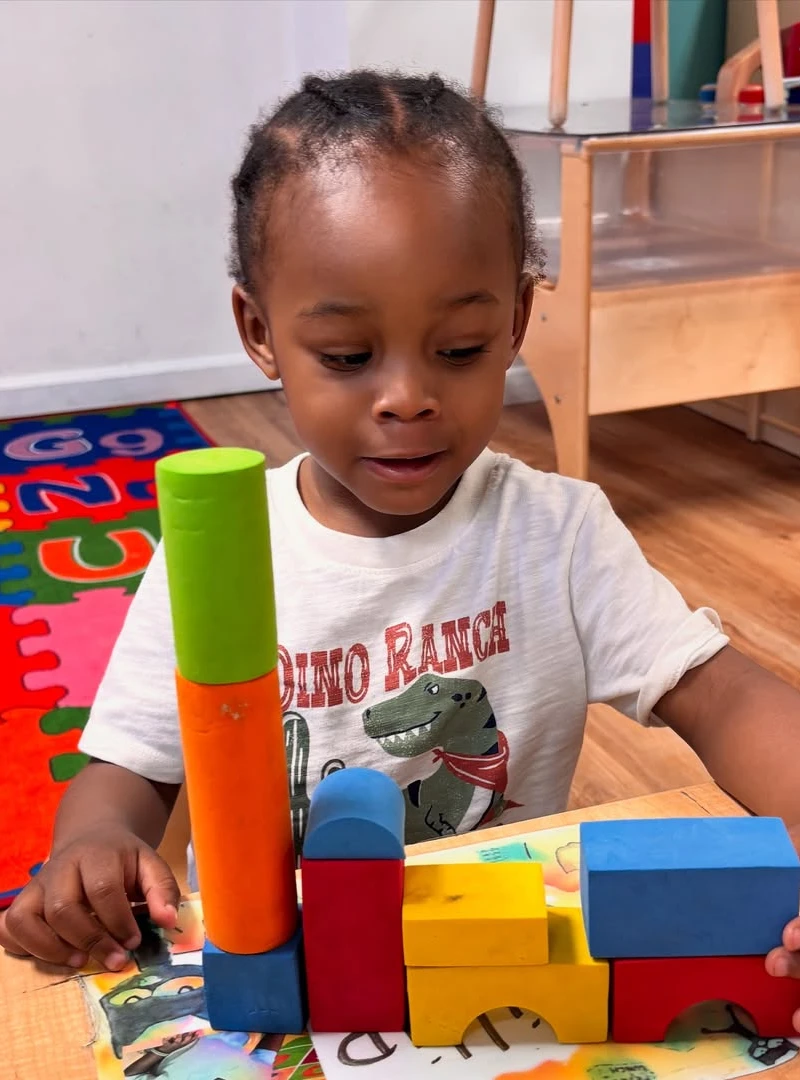
Building towers with colorful blocks might seem basic, but it’s developing spatial reasoning and problem-solving skills. This little builder is carefully balancing each piece, learning about gravity and stability through trial and error.
The satisfaction when that tower stands tall is unmatched! Blocks encourage creativity too – today it’s a tower, tomorrow it could be a castle or bridge. Stock up on different shapes and sizes to keep the construction adventures fresh.
Sometimes the simplest toys provide the richest learning experiences for growing minds.
8. Playdough Porcupine Creation
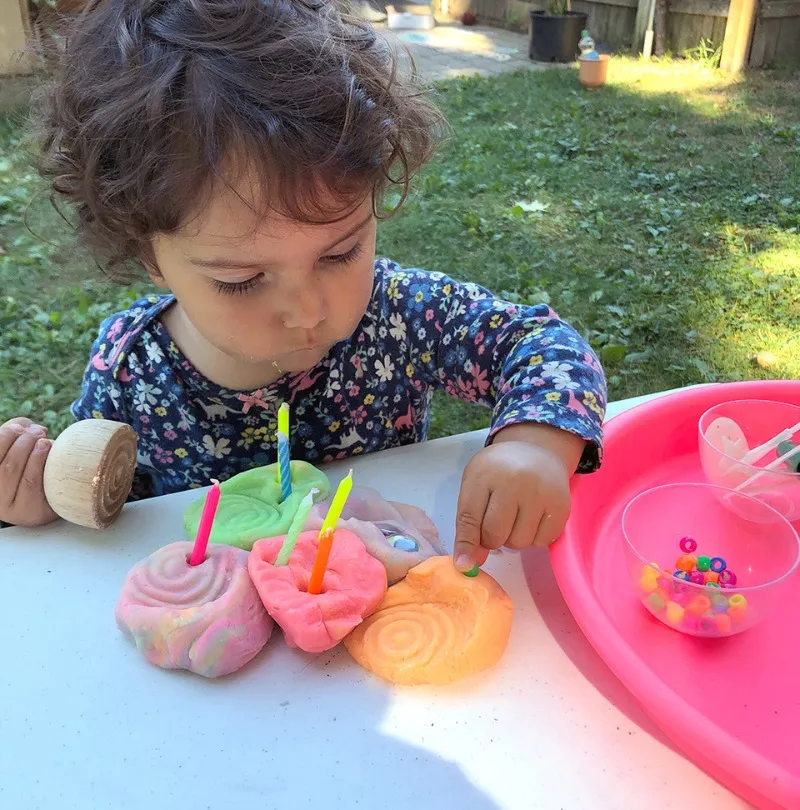
This curly-haired artist is creating a spiky porcupine using colorful dough and straws. The concentration is real as tiny fingers work to poke each “quill” into place. Playdough naturally strengthens hand muscles needed for writing later on, while the creative process sparks imagination.
Adding simple materials like straws, buttons, or pipe cleaners transforms basic dough into endless possibilities. The pink water table keeps everything contained, making cleanup a breeze.
9. Wall-Mounted Ball Drop Box
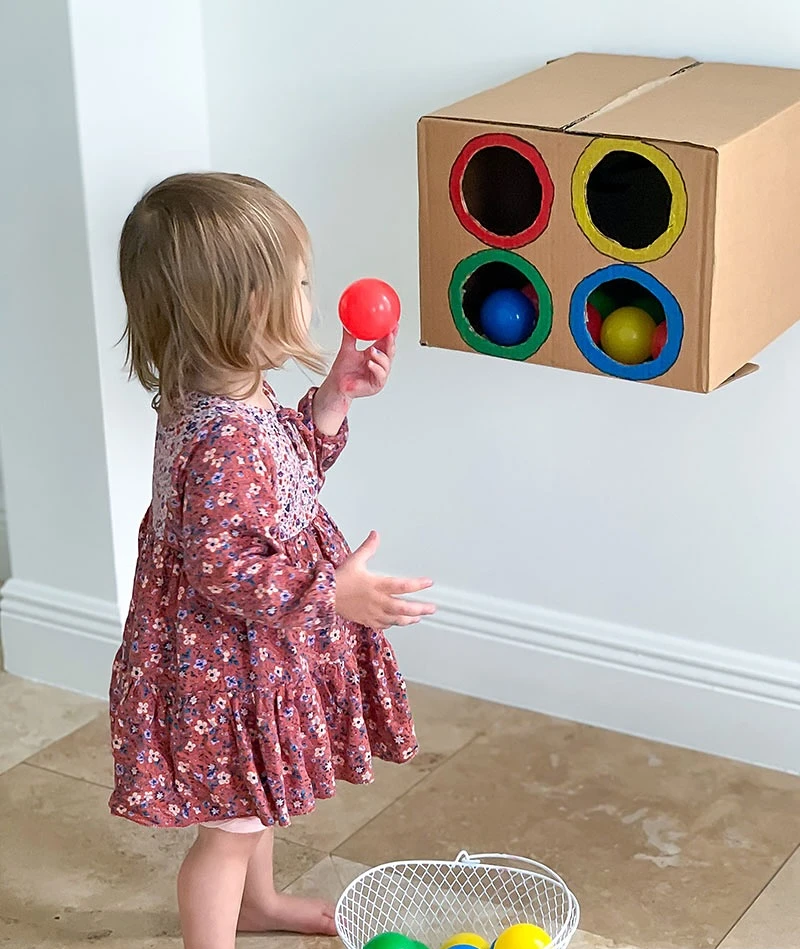
Brilliant space-saving solution right here! Mount a cardboard box to the wall, cut colorful holes, and watch your toddler become completely absorbed in this simple game. She’s learning color recognition while developing hand-eye coordination with every toss.
The beauty lies in its simplicity, just balls and holes, but the entertainment value is endless. Different-sized openings add varying difficulty levels as skills improve. When playtime ends, balls go in the basket below for easy storage.
10. Color Learning Paint Activity
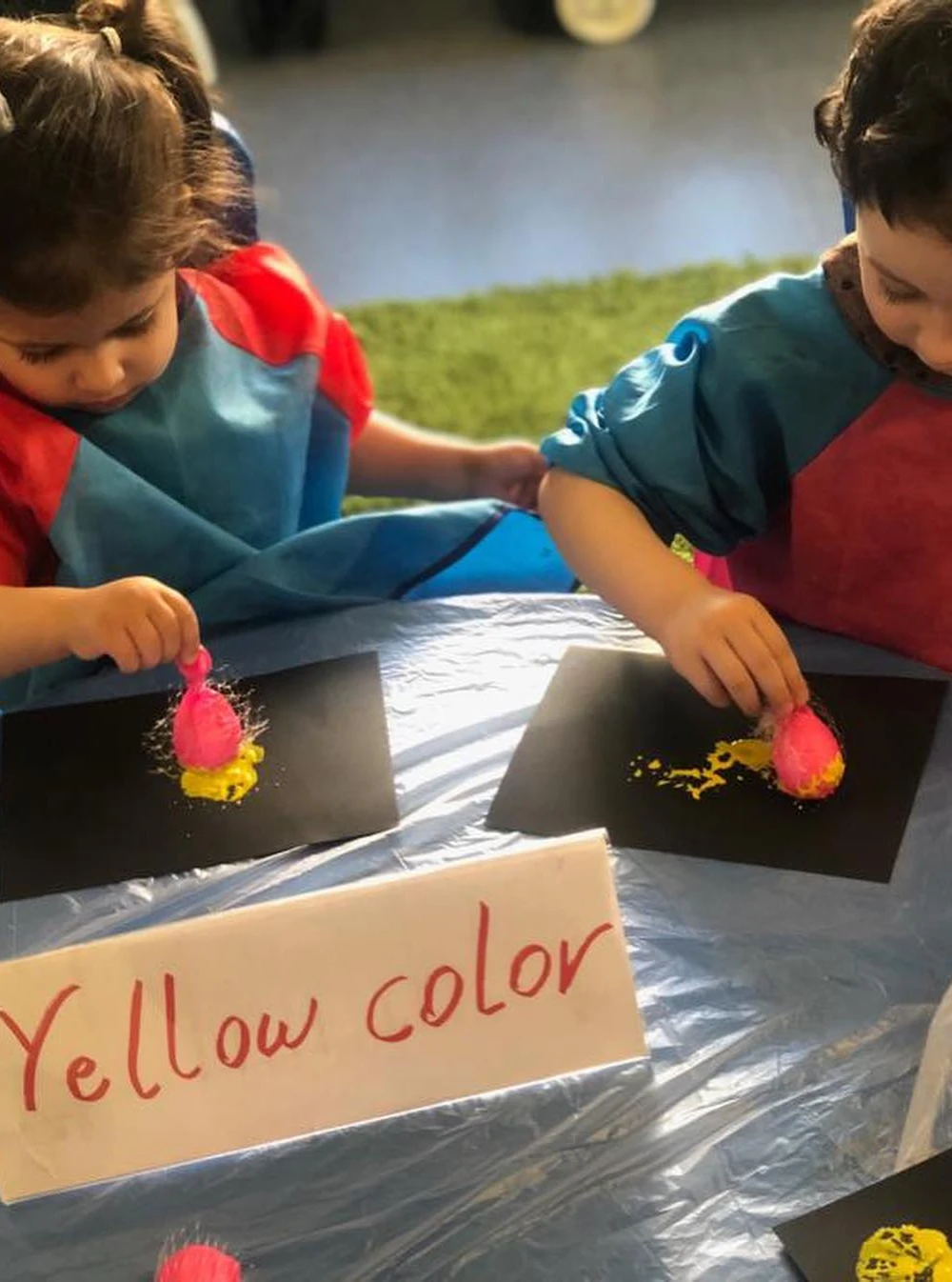
These two friends are discovering colors through hands-on exploration. Using sponge brushes and painting on black paper creates a stunning contrast that makes each hue pop. The “yellow color” label helps reinforce vocabulary while they experiment.
What’s brilliant about this setup is how it combines sensory play with early literacy – kids see the word while experiencing the color firsthand. Sometimes the messiest activities create the most memorable learning moments for little ones.
11. Letter Recognition Cup Game
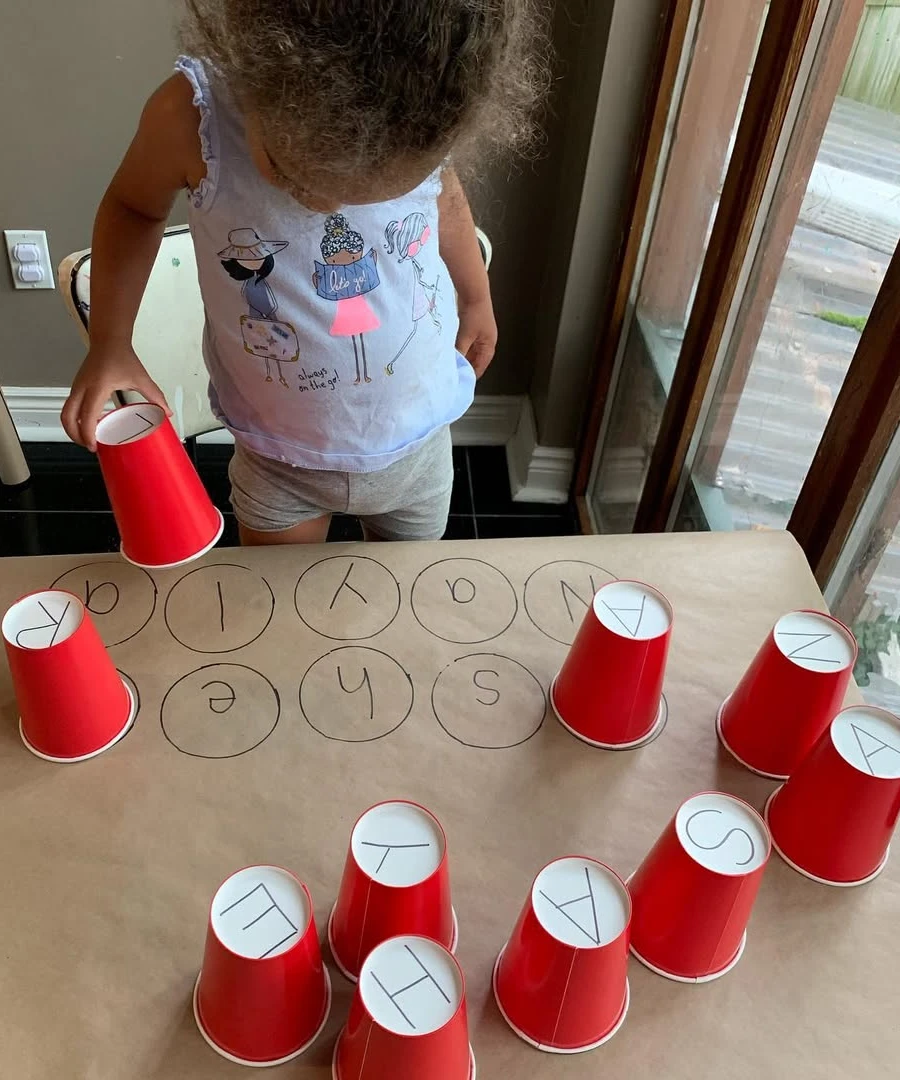
Each red cup displays a different letter, and children match them to the corresponding circles drawn on kraft paper. This standing activity gets kids moving while they learn, which helps information stick better in developing brains.
The physical act of placing each cup reinforces letter shapes through muscle memory. You can easily adapt this for numbers, shapes, or sight words as skills grow.
The beauty is in its simplicity – just cups, paper, and a marker create an engaging educational game that costs practically nothing.
12. Pumpkin Exploration Sensory Bin
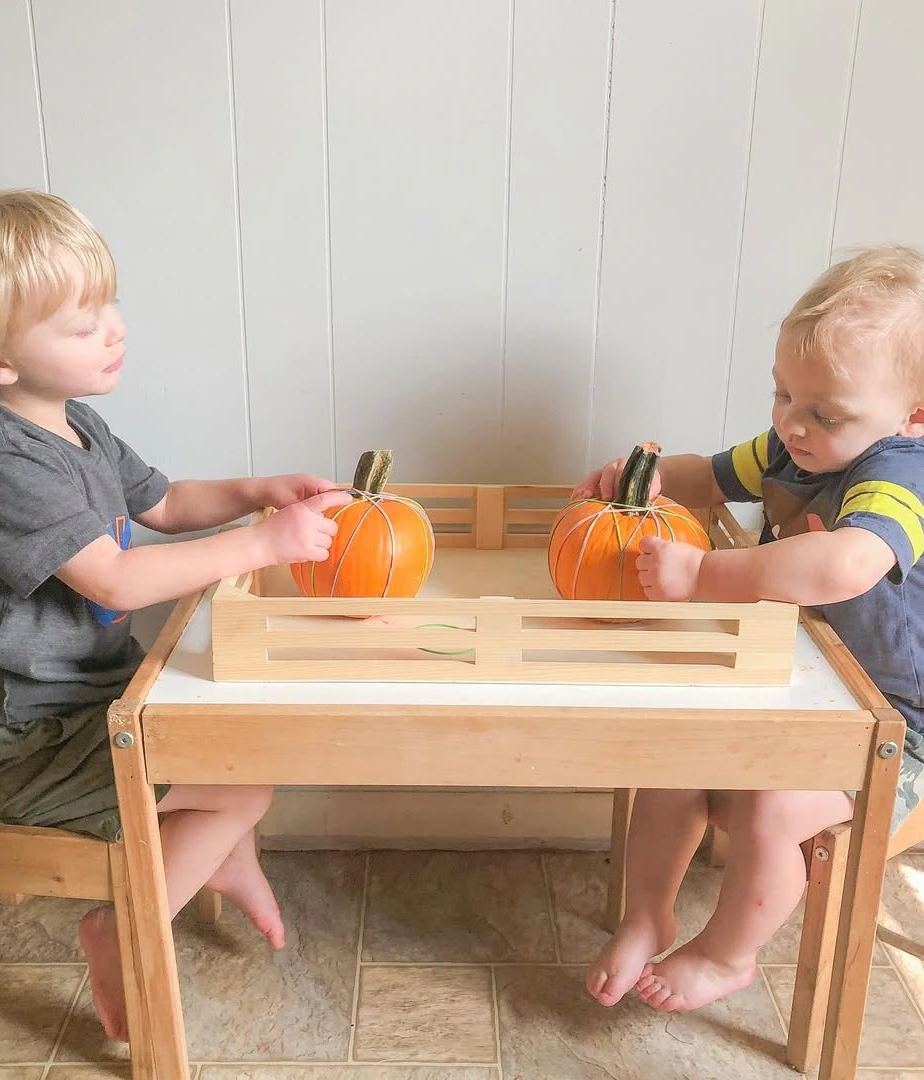
These two buddies are getting their hands dirty exploring real pumpkins in a wooden sensory table. They’re discovering textures, discussing size differences, and experiencing seasonal changes through touch. The wooden crate keeps everything contained while allowing full exploration.
Real objects beat plastic toys every time for authentic learning experiences. Plus, when they’re done exploring, those pumpkins can become tonight’s dinner!
13. DIY Art Easel Station
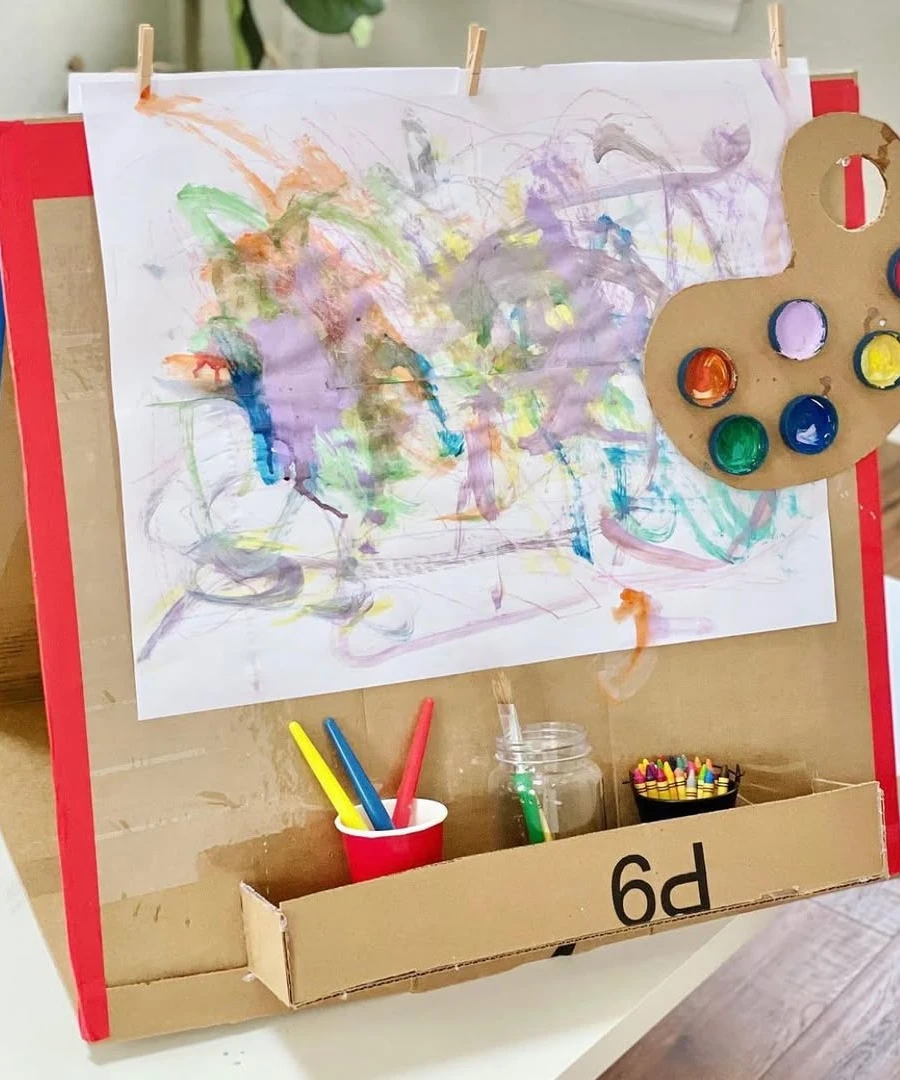
clever parent created a standing easel with built-in storage compartments for all the creative supplies. The cardboard palette adds a professional artist feel that makes kids take their work seriously.
Having everything organized and accessible encourages independent creativity – no need to ask for supplies constantly.
The wooden clothespins holding the masterpiece make it feel like a real gallery display. When creativity flows freely like this, confidence grows alongside artistic skills.
14. Balloon Number Pop Game
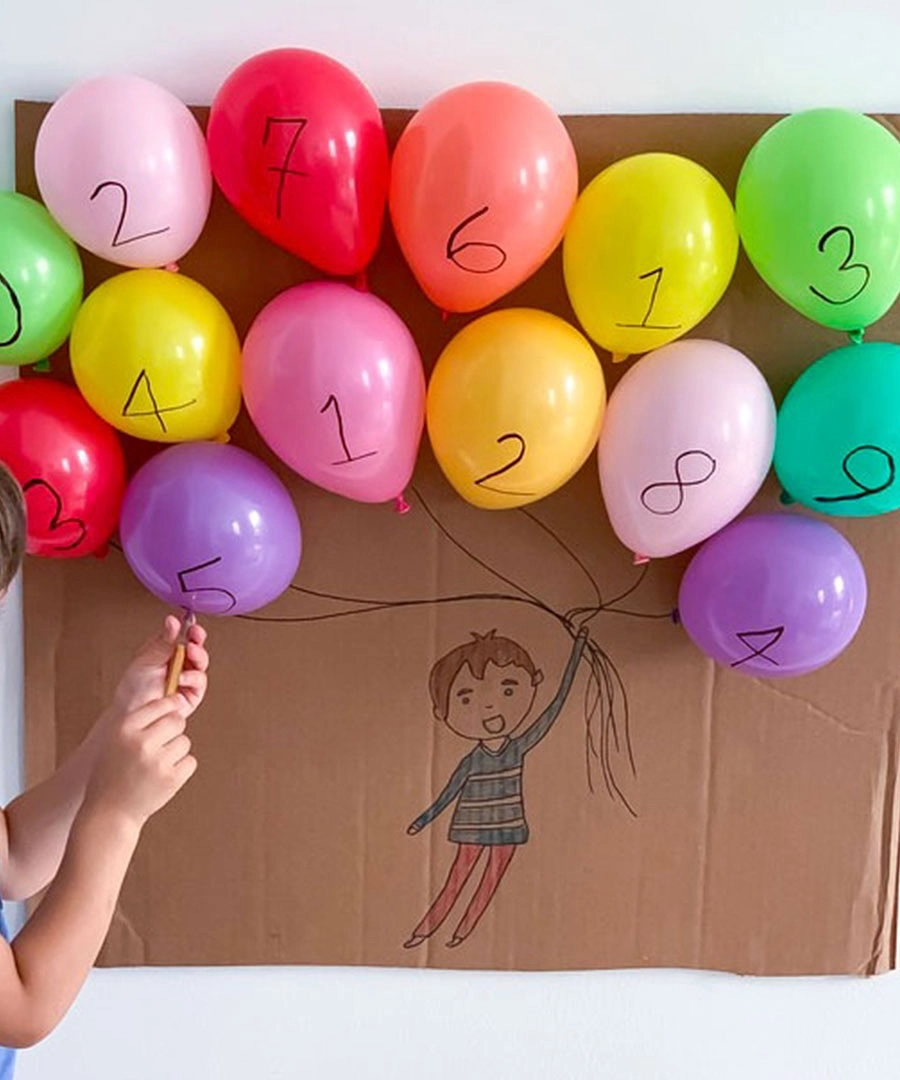
Each colorful balloon displays a number, creating a vibrant learning wall that kids can’t resist touching. The adorable drawing of a child “holding” all the balloons adds such a sweet personal touch to this educational setup.
Pop one balloon at a time while counting or call out numbers for kids to find and burst. The anticipation builds with every squeeze!
This combines physical activity with number recognition, making abstract concepts tangible and thrilling. Who knew learning could be this much of a blast?
15. Outdoor Color Sorting Challenge
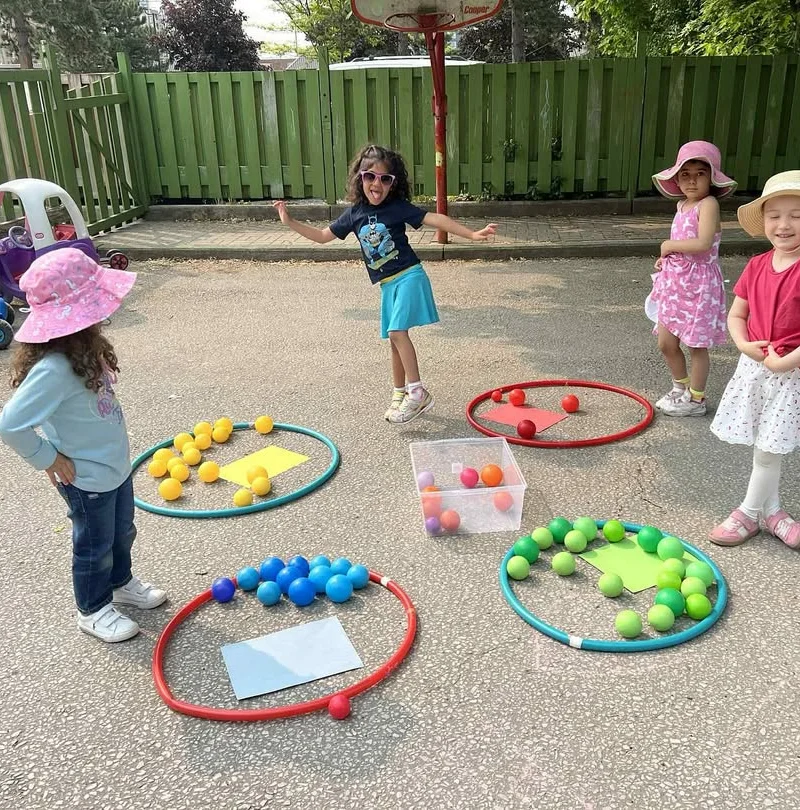
learners are having the time of their lives with this brilliant outdoor sorting activity! Hula hoops create perfect boundaries for organizing colorful balls by category, while the clear container in the center holds the mixed collection.
The excitement on their faces shows how engaged they are in this simple yet effective learning game.
Fresh air and movement make everything more enjoyable, plus there’s plenty of space for multiple children to participate together.
16. Spring Bird Nest Sensory Play
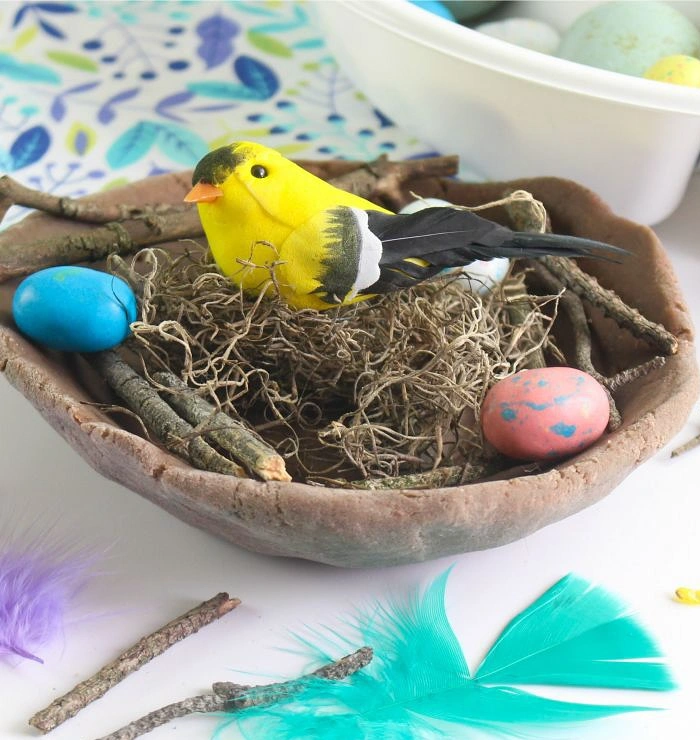
A wooden bowl filled with natural moss, twigs, and a cheerful yellow bird creates the perfect miniature habitat for exploration. Those painted eggs nestled among the materials invite gentle handling and storytelling opportunities.
Kids naturally become curious about bird life cycles, nesting behaviors, and seasonal changes through this tactile setup. The earthy textures and realistic elements engage multiple senses while sparking imagination.
It’s amazing how bringing a tiny piece of the natural world indoors can inspire such wonder and learning.
17. Musical Exploration Fun
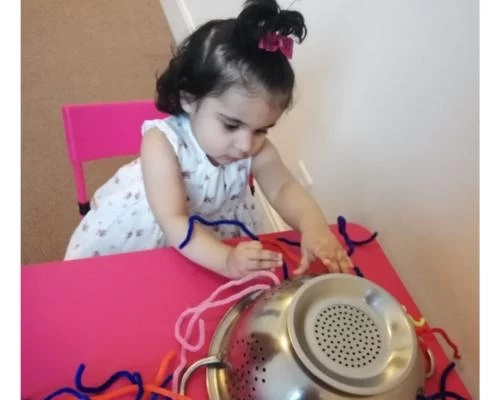
She’s got her hands on what appears to be a colander and some kitchen utensils, creating her very own percussion band. Kids naturally gravitate toward making noise, and this setup lets them explore different tones and rhythms safely.
The pink table adds a perfect pop of color to her impromptu concert. Kitchen items make fantastic musical instruments – metal bowls, wooden spoons, and even empty containers can become a toddler’s first drum set.
It’s amazing how everyday household items transform into endless entertainment.
18. Creative Art Adventure
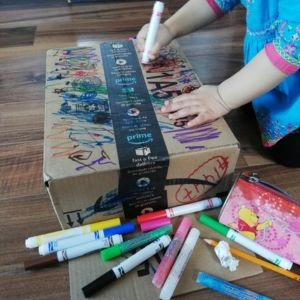
A cute artist has claimed the entire floor as her canvas, with markers scattered everywhere and a long strip of paper becoming her masterpiece. The concentrated focus on her face shows she’s completely absorbed in her artistic vision.
Art projects like this encourage self-expression while developing fine motor skills. Setting up a designated art space with washable materials gives toddlers freedom to explore colors and shapes without worry. Sometimes the biggest messes lead to the proudest moments.
19. Stacking and Sorting Challenge
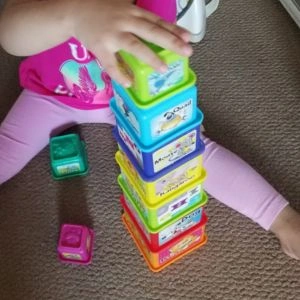
Building towers has never looked so engaging! These colorful stacking cups offer endless possibilities – from creating tall structures to nesting them inside each other.
The bright rainbow colors help toddlers learn about sequencing and size relationships while having a blast.
Simple toys develop spatial awareness, problem-solving skills, and hand-eye coordination. When the tower inevitably tumbles down, the giggles that follow make it all worthwhile. Building and rebuilding teach persistence most joyfully.
20. Learning Through Play

This interactive learning book brings education to life with its colorful owl theme and hands-on elements. The child is actively engaging with shapes, colors, and textures while following along with the activities.
Educational toys that combine learning with play help toddlers absorb concepts naturally without feeling like they’re in a classroom. The bright illustrations and tactile components keep little hands busy while developing cognitive skills.
Books like this make learning feel like an exciting game rather than a chore, building positive associations with education from an early age.
21. Foamy Block Building
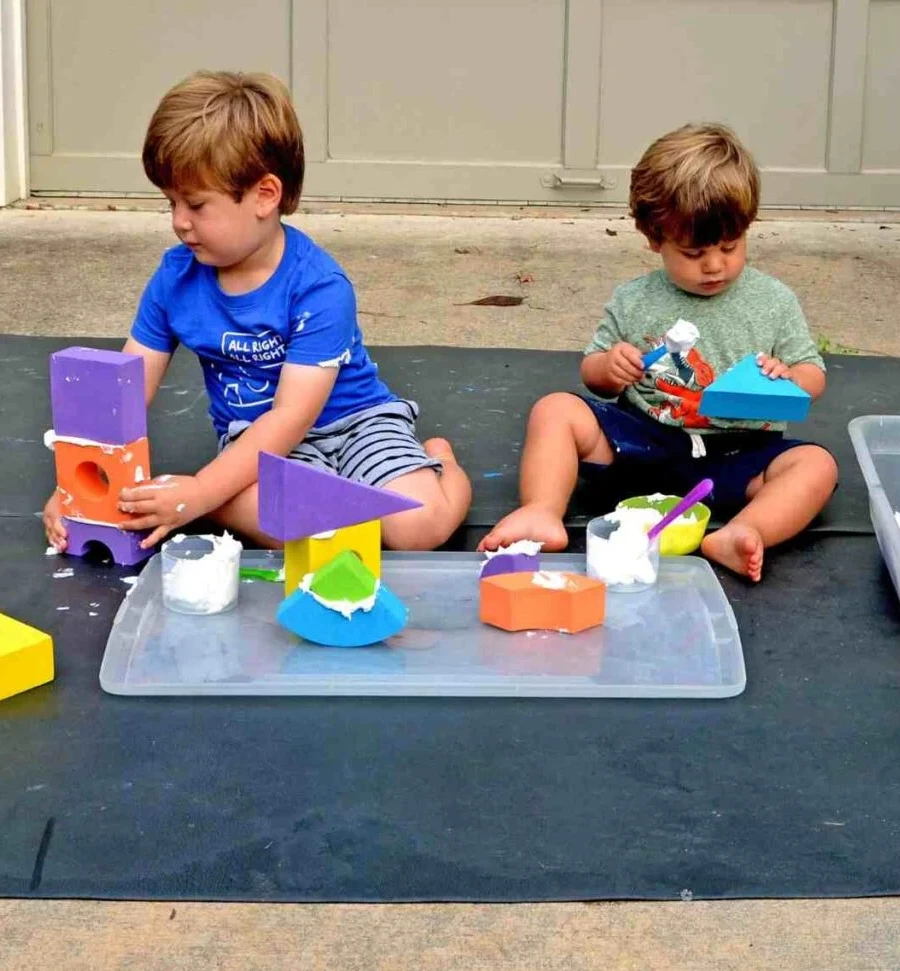
Colorful foam blocks aren’t just for stacking – they’re creating a sudsy wonderland with soap and water. The younger one seems fascinated by how slippery everything becomes when wet, while his big brother experiments with different combinations.
This activity combines construction play with water exploration, keeping busy hands occupied for ages. The mess factor might make parents nervous, but outdoor foam play develops creativity and teaches cause-and-effect relationships.
22. Muddy Science Lab
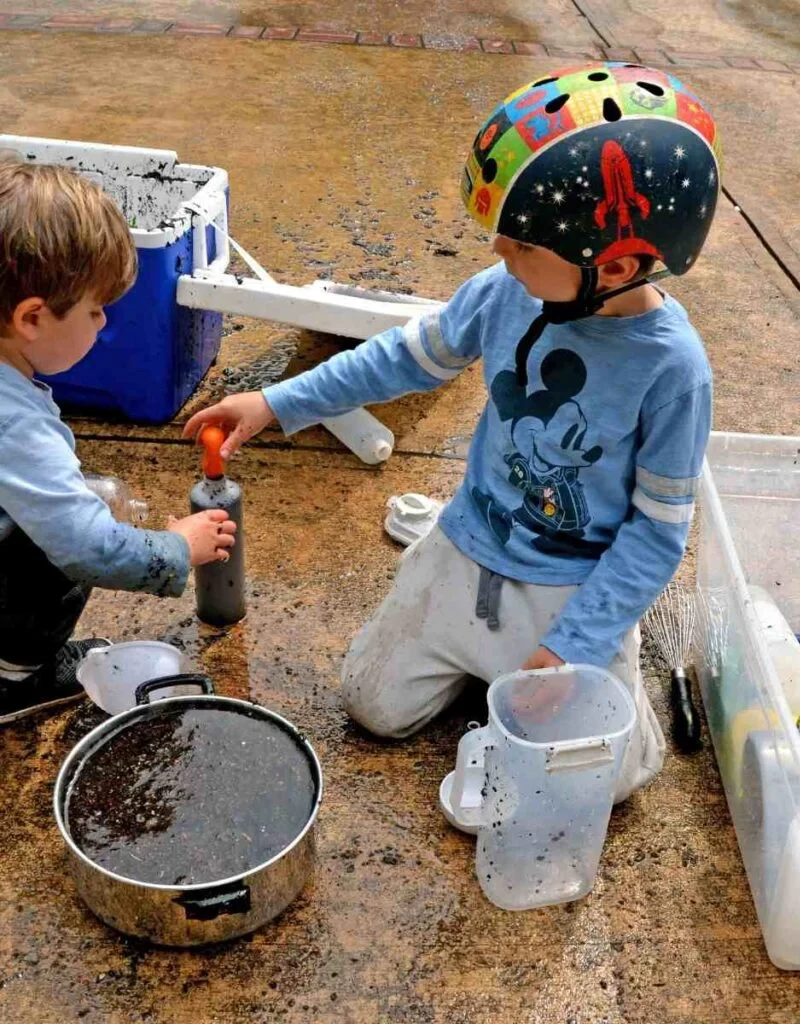
With buckets, containers, and what looks like soil or mud, they’re conducting serious experiments about mixing, pouring, and measuring. The child in the space helmet adds an extra element of imaginative play – perhaps they’re collecting samples from Mars!
Messy play like this builds scientific thinking while developing fine motor skills through scooping and transferring materials. Parents might cringe at the cleanup, but soil play is incredibly beneficial for sensory development and helps kids understand textures, weights, and how different materials behave when combined.
23. Literary Sensory Bin
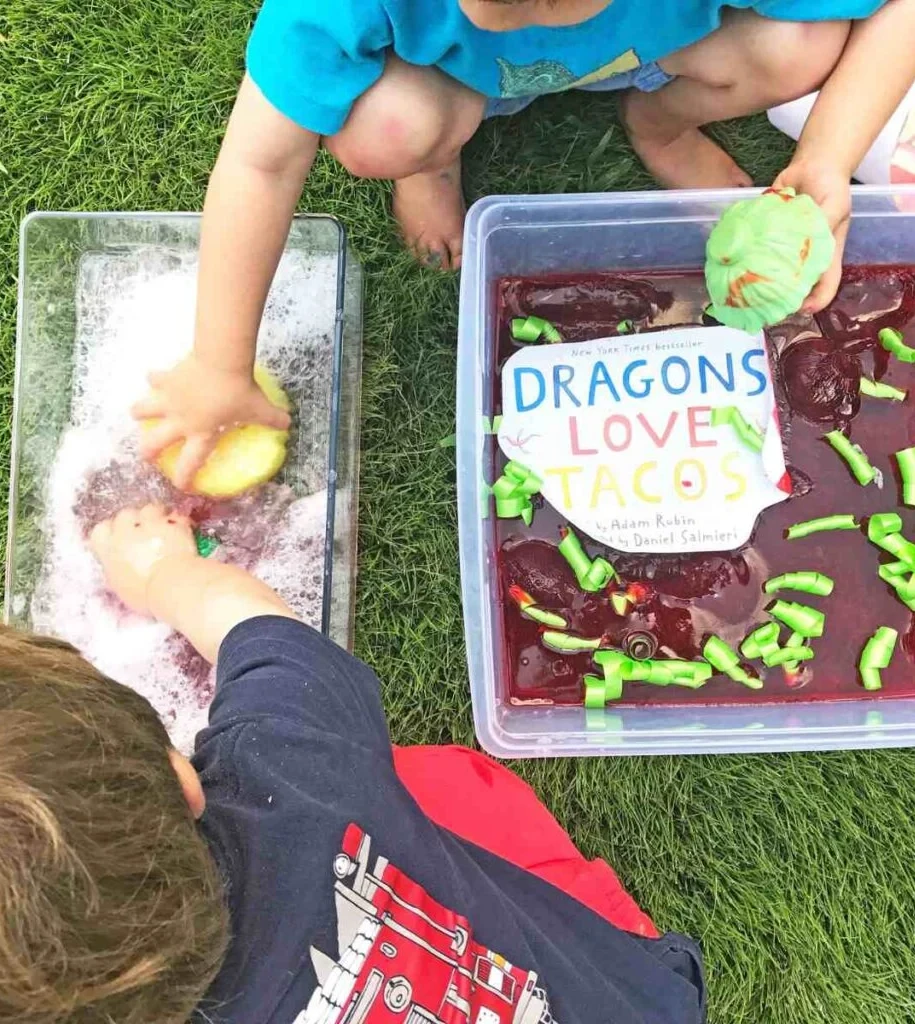
Two young readers are exploring the story through touch, with what appears to be chocolate pudding creating a messy dragon world filled with green “lettuce” pieces. Books become so much more engaging when children can physically interact with the storylines.
This hands-on approach helps cement story details in their memory while encouraging a love of reading. The tactile experience connects literature to real-world sensations, making story time an adventure that extends far beyond just turning pages.
24. Interactive Board Game Adventure
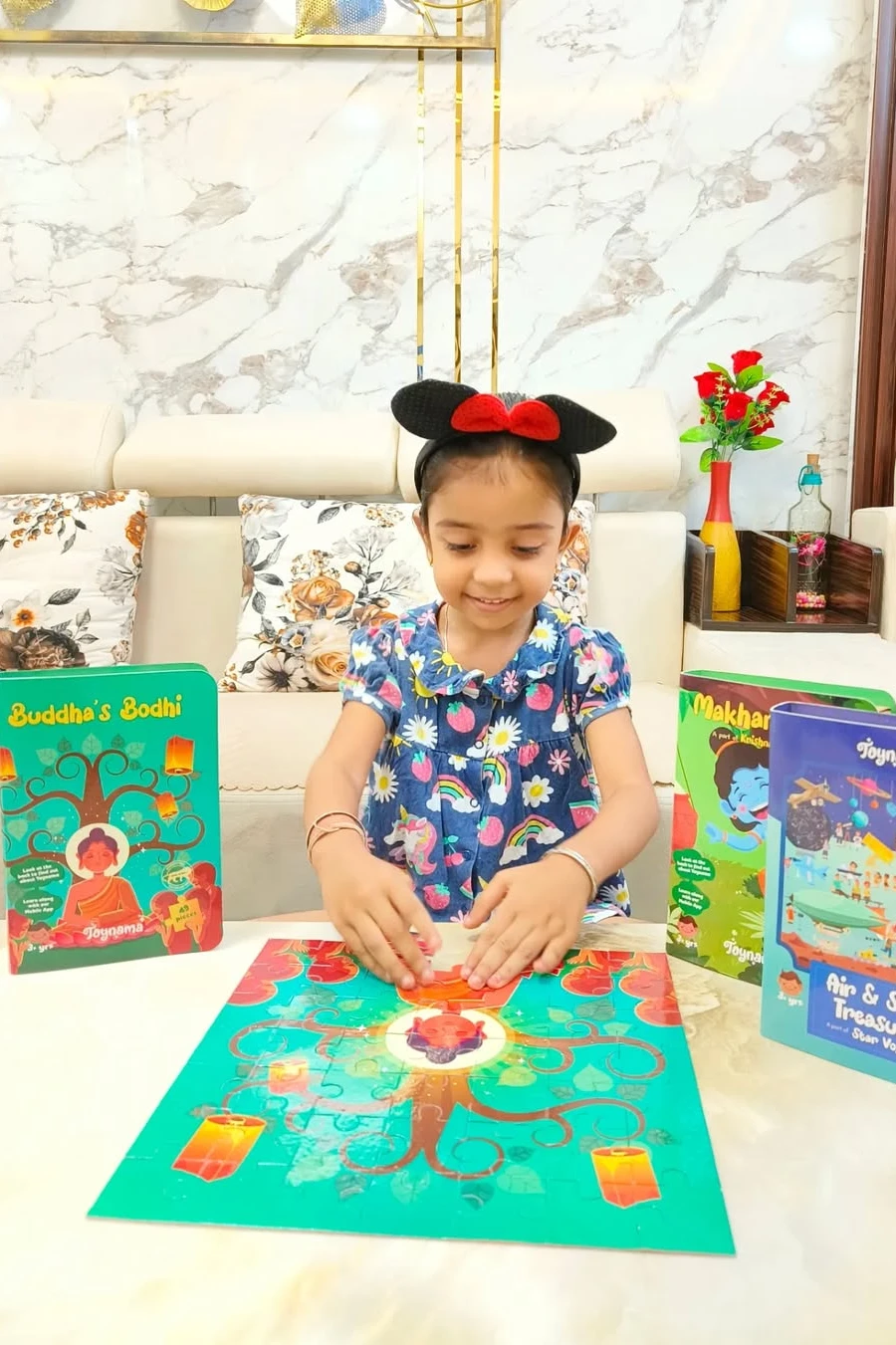
This colorful game features a winding path with vibrant illustrations that capture young attention spans. Little players can practice counting, following directions, and taking turns while moving their pieces around the track.
The bright artwork tells a story that keeps toddlers engaged even when it’s not their turn. Games like these build social skills and patience in a fun, pressure-free environment.
Set up multiple games for variety, and watch your child develop problem-solving skills while having the time of their life.
25. Rainbow Ice Excavation
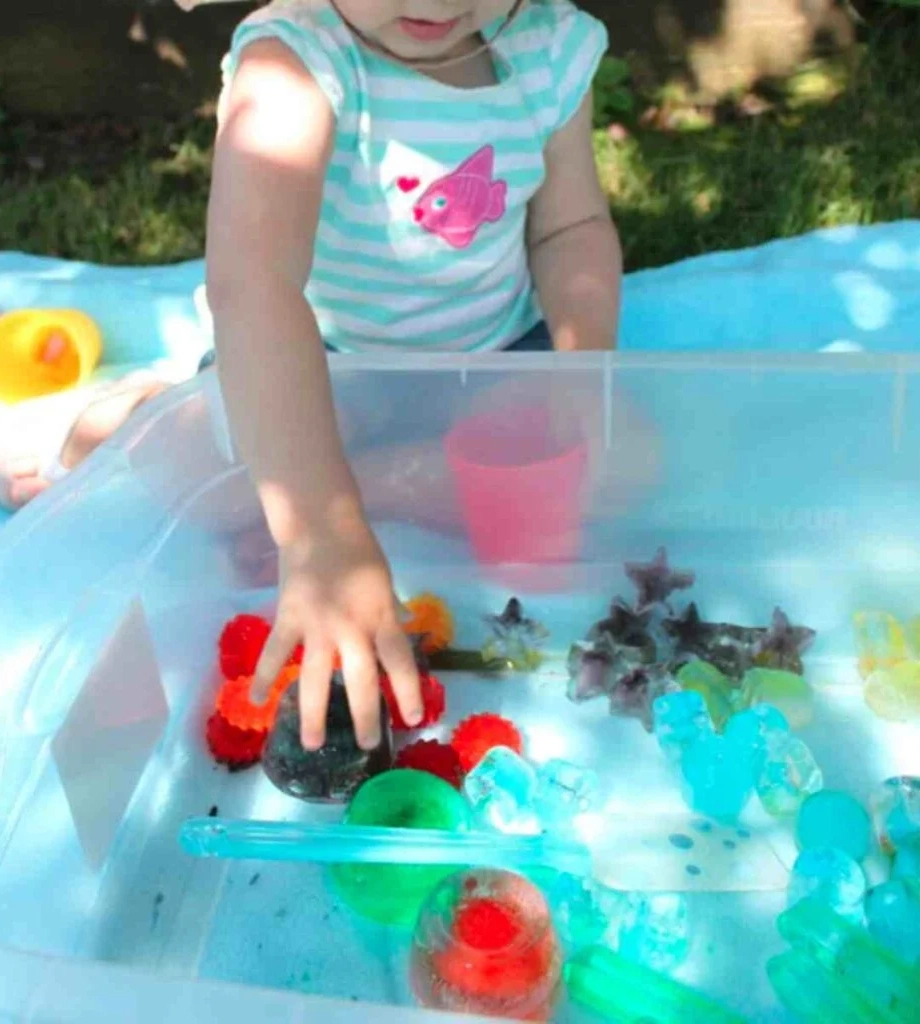
Summer heat meets scientific curiosity in this backyard water laboratory! This young researcher has discovered that frozen colored objects create the most fascinating melting experiments.
Watch how she carefully selects which icy specimen to investigate next, learning about temperature and states of matter without even realizing it. Water play combined with frozen elements provides endless entertainment while teaching basic physics concepts.
The concentration on her face shows she’s completely absorbed in understanding how things change from solid to liquid – pure science in action.
26. Lego Water Rescue Mission

These two engineers have set up the ultimate Lego rescue operation! Their transparent container has become a mini swimming pool where colorful building blocks need to be “saved” using kitchen utensils.
Water play combined with beloved toys makes even the most mundane tasks feel like epic quests. Those floating Legos aren’t just getting washed – they’re being rescued by brave heroes with ladles and strainers.
Smart parents know that making chores feel like games keeps little ones engaged while teaching responsibility and problem-solving skills.
27. Ice Block Treasure Excavation
This young archaeologist has discovered the perfect summer activity – excavating colorful treasures from massive ice blocks! Armed with tools and surrounded by her collection bins,
she’s completely absorbed in freeing those vibrant toys from their frozen prison. The melting process creates a race against time that adds excitement to the discovery.
As the ice slowly gives way, each rescued item feels like finding buried treasure. This brilliant activity combines science learning about states of matter with the thrill of treasure hunting, keeping kids engaged for hours while naturally cooling them down on hot days.
28. Bubble Solution Scientist
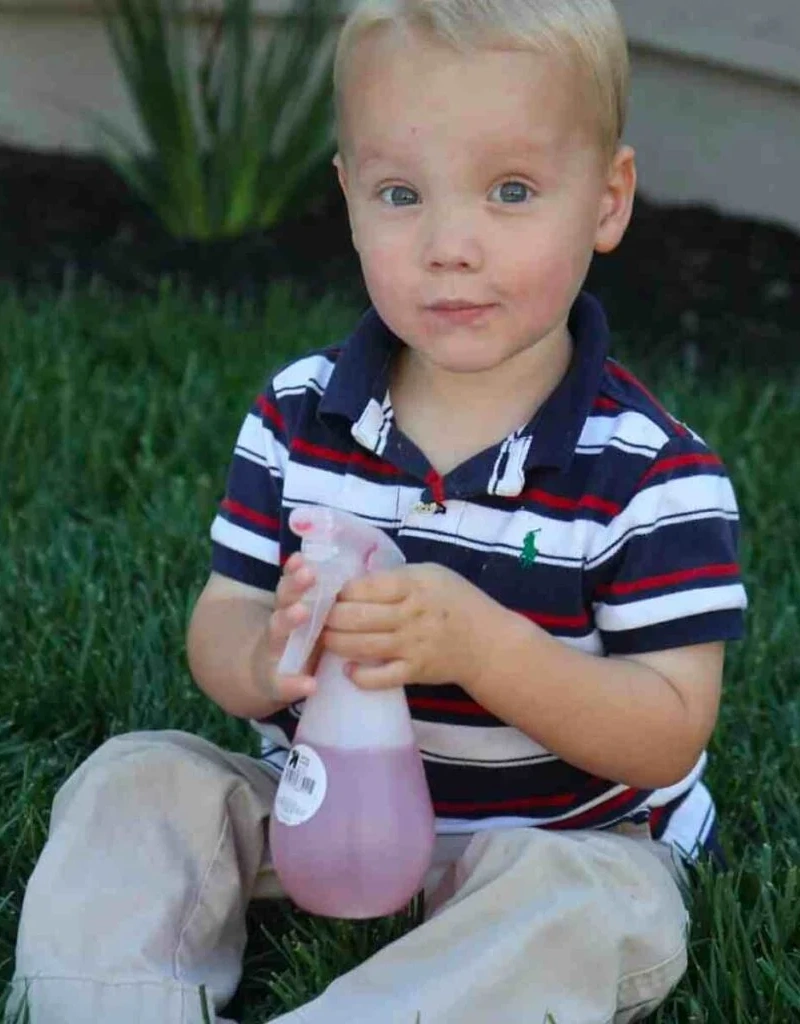
Meet the youngest bubble researcher who holds his specially mixed bubble solution, ready to conduct important experiments about surface tension and soap chemistry. The concentrated expression suggests he’s perfected his recipe through careful testing.
Making homemade bubble solution teaches kids about measurements, following directions, and cause-and-effect relationships. Different soap concentrations create varying bubble sizes and longevity.
His proud posture shows he knows he’s created something special – perhaps the secret formula for the biggest, longest-lasting bubbles ever seen in his backyard laboratory.
29. Sensory Block Exploration Zone
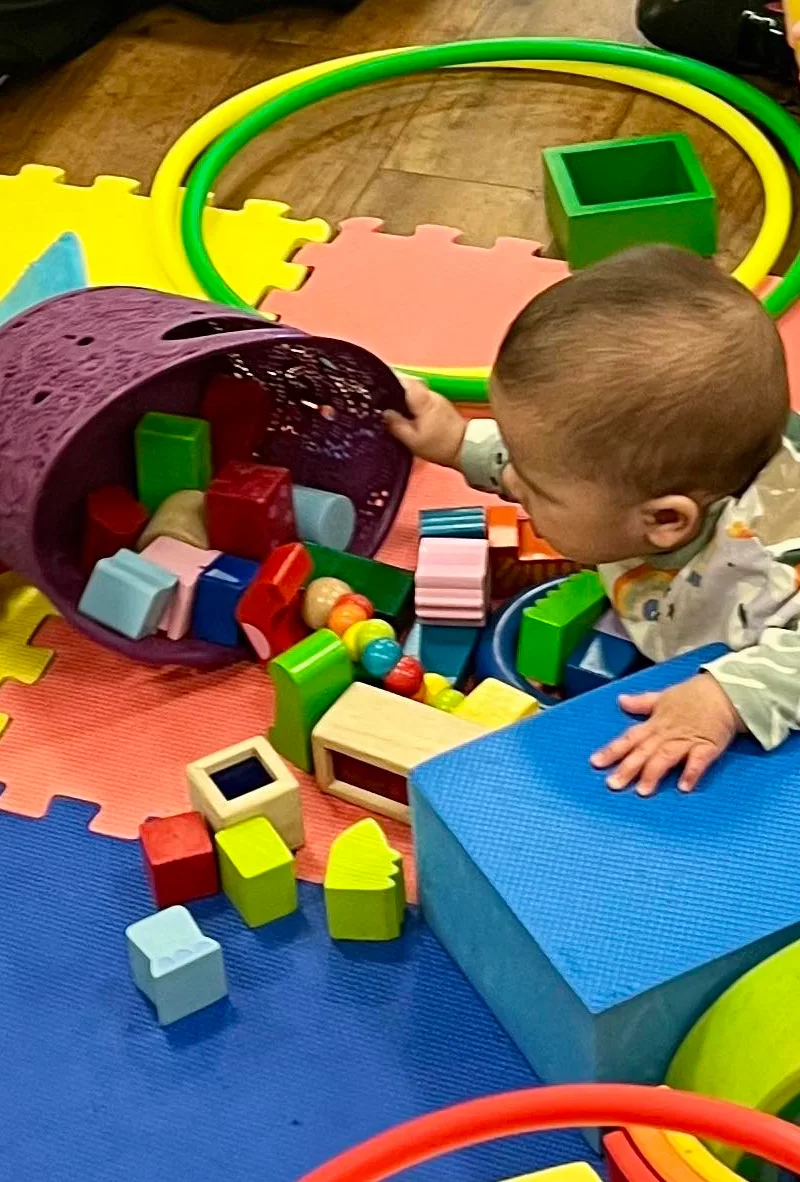
Create an exciting discovery area using foam blocks, textured containers, and soft play mats. Dump different-sized blocks into baskets and watch your toddler’s natural curiosity take over.
They’ll love reaching in, grabbing handfuls, and feeling the various textures. The squishy foam is safe for throwing and stacking, while the colorful variety keeps visual interest high.
Toddlers can practice sorting by size, color, or simply enjoy the satisfying feeling of blocks tumbling everywhere. Easy cleanup makes this a parent-friendly activity
30. Ocean Adventure Bath Time
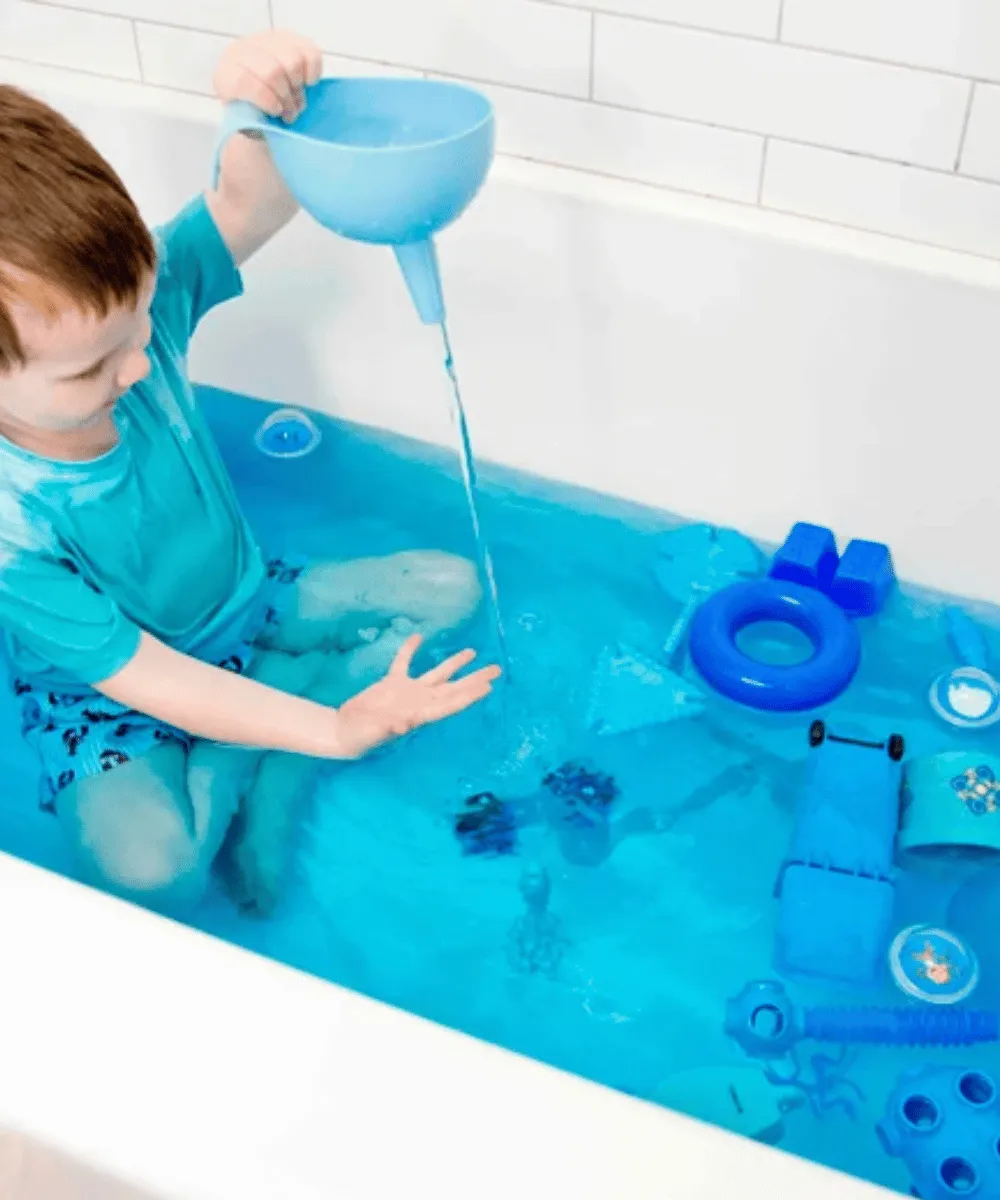
Someone turned bath time into an underwater expedition! That gorgeous blue water transforms an ordinary tub into a magical ocean where imagination runs wild.
The concentrated pouring and exploration happening here build fine motor skills while the sensory-rich colored water adds extra excitement.
Bath time becomes adventure time when you think outside the box – or in this case, inside the tub!
31. Sensory Archaeology Dig
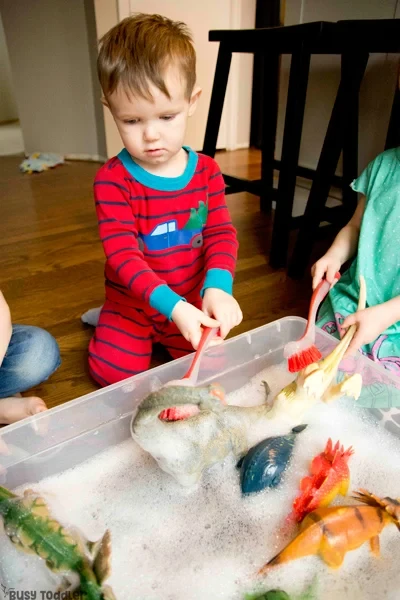
Welcome to the most engaging science lab ever created! This textured sensory bin has become an archaeological expedition where little hands can dig, brush, and discover hidden treasures.
The focused concentration shows how deeply engaged these young explorers are in their tactile investigation. Sensory play like this builds neural pathways while satisfying that natural urge to touch, explore, and learn through hands-on discovery.

